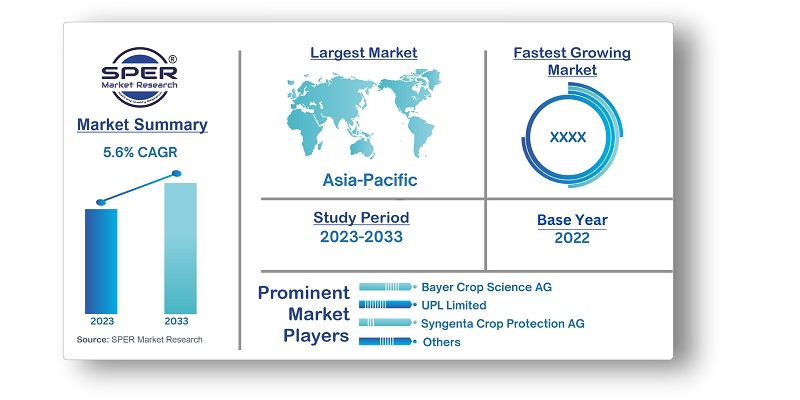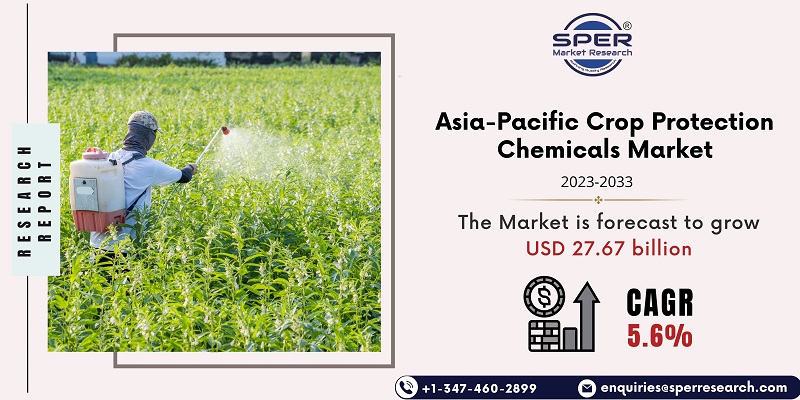
Asia Pacific Crop Protection Chemicals Market Growth, Size, Trends, Revenue and Future Outlook
Asia Pacific Crop Protection Chemicals Market Size– By Type, By Origin, By Application- Regional Outlook, Competitive Strategies and Segment Forecast to 2033
| Published: Jan-2024 | Report ID: AGRI2403 | Pages: 1 - 157 | Formats*: |
| Category : Agriculture | |||
- June 2022: FMC India declared in June 2022 that Austral herbicide, a new pre-emergent herbicide for sugarcane crops, would be available. During the crucial growth stage of sugarcane, austral herbicide offers a new degree of broad-spectrum weed control, assuring the crop's solid establishment for a higher yield.
- September 2022: Syngenta introduced "Monecto Xtra," a new generation of fungicide, to Indian rice farmers. Cyantraniliprole (16.9%) and Lufenuron (16.9%) SC are the two chemical combinations that make up Minecto Xtra's dual-mode activity.


| Report Metric | Details |
| Market size available for years | 2019-2033 |
| Base year considered | 2022 |
| Forecast period | 2023-2033 |
| Segments covered | By Type, By Origin, By Application |
| Regions covered | Australia, China, India, Japan, Rest of Asia-Pacific |
| Companies Covered | Bayer Crop Science AG, UPL Limited, Syngenta Crop Protection AG, FMC Corporation, BASF SE, Adama Ltd, Sumitomo Chemical Co. Ltd., KUMIAI CHEMICAL INDUSTRY CO. LTD., Nufarm Limited, Shandong Weifang Rainbow Chemical Co. Ltd and various others. |
- Farmers and Growers
- Agricultural Input Suppliers
- Agrochemical Manufacturers
- Distributors and Retailers
- Government and Regulatory Bodies
- Academic Institutions
- Investors and Financial Institutions
- Industry Associations and Trade Groups
- Technology Providers
- Farm Advisory Services
| By Type: |
|
| By Origin: |
|
| By Application: |
|
- Asia-Pacific Crop Protection Chemicals Market Size (FY’2023-FY’2033)
- Overview of Asia-Pacific Crop Protection Chemicals Market
- Segmentation of Asia-Pacific Crop Protection Chemicals Market By Type (Fungicide, Herbicide, Insecticide, Other Types)
- Segmentation of Asia-Pacific Crop Protection Chemicals Market By Origin (Bio-based, Synthetic)
- Segmentation of Asia-Pacific Crop Protection Chemicals Market By Application (Commercial Crops, Fruits and Vegetables, Grains and Cereals, Pulses and Oilseeds, Other Applications)
- Statistical Snap of Asia-Pacific Crop Protection Chemicals Market
- Expansion Analysis of Asia-Pacific Crop Protection Chemicals Market
- Problems and Obstacles in Asia-Pacific Crop Protection Chemicals Market
- Competitive Landscape in the Asia-Pacific Crop Protection Chemicals Market
- Impact of COVID-19 and Demonetization on Asia-Pacific Crop Protection Chemicals Market
- Details on Current Investment in Asia-Pacific Crop Protection Chemicals Market
- Competitive Analysis of Asia-Pacific Crop Protection Chemicals Market
- Prominent Players in the Asia-Pacific Crop Protection Chemicals Market
- SWOT Analysis of Asia-Pacific Crop Protection Chemicals Market
1.1. Scope of the report1.2. Market segment analysis
2.1. Research data source2.1.1. Secondary Data2.1.2. Primary Data2.1.3. SPER’s internal database2.1.4. Premium insight from KOL’s2.2. Market size estimation2.2.1. Top-down and Bottom-up approach2.3. Data triangulation
4.1. Driver, Restraint, Opportunity and Challenges analysis4.1.1. Drivers4.1.2. Restraints4.1.3. Opportunities4.1.4. Challenges4.2. COVID-19 Impacts of the Asia-Pacific Crop Protection Chemicals Market
5.1. SWOT Analysis5.1.1. Strengths5.1.2. Weaknesses5.1.3. Opportunities5.1.4. Threats5.2. PESTEL Analysis5.2.1. Political Landscape5.2.2. Economic Landscape5.2.3. Social Landscape5.2.4. Technological Landscape5.2.5. Environmental Landscape5.2.6. Legal Landscape5.3. PORTER’s Five Forces5.3.1. Bargaining power of suppliers5.3.2. Bargaining power of buyers5.3.3. Threat of Substitute5.3.4. Threat of new entrant5.3.5. Competitive rivalry5.4. Heat Map Analysis
6.1. Asia-Pacific Crop Protection Chemicals Market Manufacturing Base Distribution, Sales Area, Product Type6.2. Mergers & Acquisitions, Partnerships, Product Launch, and Collaboration in Asia-Pacific Crop Protection Chemicals Market
7.1. Asia-Pacific Crop Protection Chemicals Market Value Share and Forecast, By Type, 2023-20337.2. Fungicide7.3. Herbicide7.4. Insecticide7.5. Other Types
8.1. Asia-Pacific Crop Protection Chemicals Market Value Share and Forecast, By Origin, 2023-20338.2. Bio-based8.3. Synthetic
9.1. Asia-Pacific Crop Protection Chemicals Market Value Share and Forecast, By Application, 2023-20339.2. Commercial Crops9.3. Fruits and Vegetables9.4. Grains and Cereals9.5. Pulses and Oilseeds9.6. Other Applications
10.1. Asia-Pacific Crop Protection Chemicals Market Size and Market Share
11.1. Asia-Pacific Crop Protection Chemicals Market Size and Market Share By Type (2019-2026)11.2. Asia-Pacific Crop Protection Chemicals Market Size and Market Share By Type (2027-2033)
12.1. Asia-Pacific Crop Protection Chemicals Market Size and Market Share By Origin (2019-2026)12.2. Asia-Pacific Crop Protection Chemicals Market Size and Market Share By Origin (2027-2033)
13.1. Asia-Pacific Crop Protection Chemicals Market Size and Market Share By Application (2019-2026)13.2. Asia-Pacific Crop Protection Chemicals Market Size and Market Share By Application (2027-2033)
14.1. Asia-Pacific Crop Protection Chemicals Market Size and Market Share By Region (2019-2026)14.2. Asia-Pacific Crop Protection Chemicals Market Size and Market Share By Region (2027-2033)14.2.1. Australia14.2.2. China14.2.3. India14.2.4. Japan14.2.5. Rest of Asia-Pacific
15.1. Adama Ltd.15.1.1. Company details15.1.2. Financial outlook15.1.3. Product summary15.1.4. Recent developments15.2. BASF SE15.2.1. Company details15.2.2. Financial outlook15.2.3. Product summary15.2.4. Recent developments15.3. Bayer Crop Science AG15.3.1. Company details15.3.2. Financial outlook15.3.3. Product summary15.3.4. Recent developments15.4. FMC Corporation15.4.1. Company details15.4.2. Financial outlook15.4.3. Product summary15.4.4. Recent developments15.5. Kumiai Chemical Industry co. Ltd.15.5.1. Company details15.5.2. Financial outlook15.5.3. Product summary15.5.4. Recent developments15.6. Nufarm Limited15.6.1. Company details15.6.2. Financial outlook15.6.3. Product summary15.6.4. Recent developments15.7. Shandong Weifang Rainbow Chemical Co. Ltd.15.7.1. Company details15.7.2. Financial outlook15.7.3. Product summary15.7.4. Recent developments15.8. Syngenta Crop Protection AG15.8.1. Company details15.8.2. Financial outlook15.8.3. Product summary15.8.4. Recent developments15.20 Others
SPER Market Research’s methodology uses great emphasis on primary research to ensure that the market intelligence insights are up to date, reliable and accurate. Primary interviews are done with players involved in each phase of a supply chain to analyze the market forecasting. The secondary research method is used to help you fully understand how the future markets and the spending patterns look likes.
The report is based on in-depth qualitative and quantitative analysis of the Product Market. The quantitative analysis involves the application of various projection and sampling techniques. The qualitative analysis involves primary interviews, surveys, and vendor briefings. The data gathered as a result of these processes are validated through experts opinion. Our research methodology entails an ideal mixture of primary and secondary initiatives.



Frequently Asked Questions About This Report
PLACE AN ORDER
Year End Discount
Sample Report
Pre-Purchase Inquiry
NEED CUSTOMIZATION?
Request CustomizationCALL OR EMAIL US
100% Secure Payment






Related Reports
Our Global Clients
Our data-driven insights have influenced the strategy of 200+ reputed companies across the globe.






















